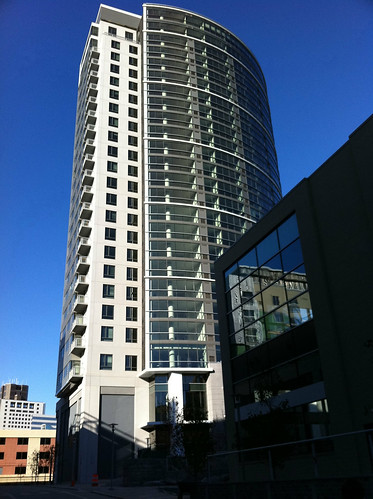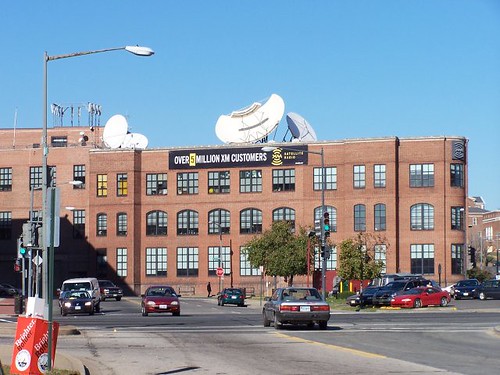The DC height limit revisited

Flickr image of the North Bethesda Market East building, a mostly residential with ground floor retail on Rockville Pike in the White Flint District of Montgomery County by DearEdward.
Today's Post has an article, Gray, Issa consider relaxing D.C. building height limits" that Republican Rep. Darrell Issa is open to the height limit for buildings being punctured. Also see "How Important Is It That Darrell Issa Is Talking Sense on Height Limits?" in the City Paper.
While concerned about viewshed aspects and other historic preservation implications, I have come around to favor a building height increase for three reasons:
1. The limit on inventory of available space means that prices per square foot are higher for commercial space, creating opportunities for Alexandria and Arlington Counties especially to recruit businesses, agencies, and other organizations that might otherwise locate in DC.
2. Because of the relatively high cost of space, most non-federally related (trade associations, law firms, lobbyists) uses get crowded out of Downtown/the city is because the height limit makes space more expensive. So the "commerce ecology" present in the city is stunted, less creative, more of a federal monoculture, which makes the local economy less resilient.
3. Because it can't grow upward, the "central" business district inexorably moves outward (NoMA, M Street SE, etc.), reproducing space in ways that can have deleterious consequences, such as in the loss of most of the old warehouse buildings in what is now called the NoMA district.
Note that for to see significant impact if building heights could go up significantly, rather than just a floor or two, it will take 2-4 decades. It takes a long time to see the impact of cumulative changes from real estate development, because of the long sales and development cycles.
From the Post article:
Under the Height Act, a building on a commercial street can not exceed 20 feet greater than the width of the facing street, to a maximum of 130 feet. There is an exception on Pennsylvania Avenue between 1st and 15th streets NW, where buildings can rise to 160 feet.
On a residential street in the District, maximum building height is generally 10 feet greater than the width of the street, to a maximum of 90 feet.
But the limits allow for mechanical equipment rooms and non-habitable enclosures on many rooftops, which can increase the maximum by up to 18.5 feet. In his conversations with Issa, Gray has proposed allowing that extra space to be used as “living space.”
“It wouldn’t actually raise the height limit but could add a floor to a lot of buildings, which could substantially grow the population as well as the tax income of the city,” Gray said.

The former Judd & Detwiler printing plant on Florida Avenue/Eckington Place has been repurposed and is a production facility for Sirius Satellite Radio. But the area around this building was once home to many other similar kinds of buildings, most of which have been demolished, in favor of other types of development. Photo by BeyondDC.
Arguably, that kind of expansion through extension of the central business district is beneficial to those other areas.
But it still comes at a cost, because the rent/sq. foot isn't substantively cheaper than space downtown, and the kinds of "innovative" uses that benefit from urban location a la Jane Jacobs are priced out.
Others have suggested puncturing the height limit outside of the core CBD but I don't think that would have the impact that people think, except maybe for residential a la Rockville Pike in "North Bethesda" or Grosvenor in Montgomery County, because commercial location would still be most desirable in the core.
Just because there could be a tall building in DC neighborhoods like Friendship Heights or Fort Lincoln doesn't mean that a business would necessarily want to locate there, because there wouldn't be favorable "agglomeration economies" or benefits from being located by other businesses and people, just lower rents. It's not like the office buildings in Takoma Park (one in DC, one in MD) are in high demand. It's Class B/C space serving tenants looking for cheap space. If there were Class A commercial space, the likelihood of there being high demand for it is minimal.
For similar reasons there is debate about how to "revitalize" Wheaton and what kind of office development is appropriate. (See "Montgomery council approves Wheaton redevelopment plan" from the Post.)
I argue that if you have to provide mostly government agencies to seed the office, then the market isn't there. That's ok, but the reality is that business in Montgomery County will still prefer to locate in the Rockville Pike and I-270 corridors to reap the benefits of agglomeration economies.
Same goes for DC. If you want substantive impact from allowing much taller buildings (as opposed to another floor or two) in DC, then they need to be built downtown, but in any case, I will be dead (figuring that I can live at least 30 more years, hopefully) before much impact will be discernible.
Labels: agglomeration economies, commercial district revitalization planning, electoral politics and influence, historic preservation, real estate development, urban design/placemaking



2 Comments:
I recently read an article discussing the height of buildings in London, England. It mentioned how they thought the trend of new skyscrapers were ruining the picturesque landscape, I'm not too sure where I lie on this one but being a part of the construction industry and working with Promax, I have to say I support anything that increases demand. Right now, times are very tough, I've never known it to be this quiet and I can't see things improving anytime soon.
Thank you again for your flawless service, and I look forward to working with you in the future.
Post a Comment
<< Home